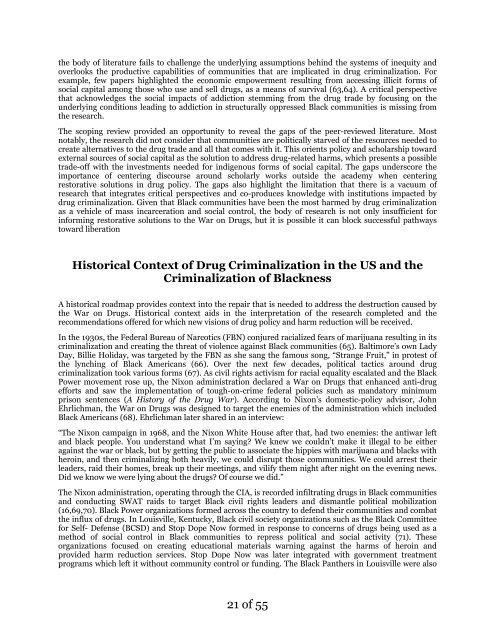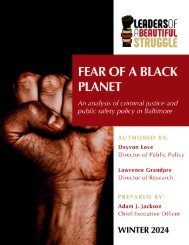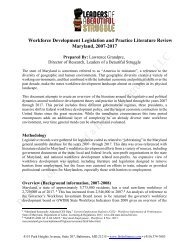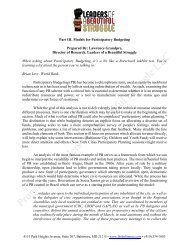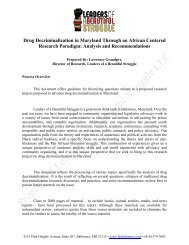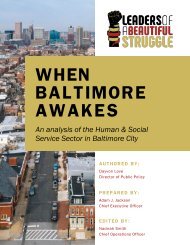The Communal Impacts of Drug Criminalization in Maryland
This project attempts to reframe the harms of drug criminalization. Influenced by African-Centered Research Methodologies, we engaged in a literature review and qualitative research of the communal impacts of drug decriminalization in Maryland, with a specific focus on Baltimore.
This project attempts to reframe the harms of drug criminalization. Influenced by African-Centered Research Methodologies, we engaged in a literature review and qualitative research of the communal impacts of drug decriminalization in Maryland, with a specific focus on Baltimore.
You also want an ePaper? Increase the reach of your titles
YUMPU automatically turns print PDFs into web optimized ePapers that Google loves.
the body <strong>of</strong> literature fails to challenge the underly<strong>in</strong>g assumptions beh<strong>in</strong>d the systems <strong>of</strong> <strong>in</strong>equity and<br />
overlooks the productive capabilities <strong>of</strong> communities that are implicated <strong>in</strong> drug crim<strong>in</strong>alization. For<br />
example, few papers highlighted the economic empowerment result<strong>in</strong>g from access<strong>in</strong>g illicit forms <strong>of</strong><br />
social capital among those who use and sell drugs, as a means <strong>of</strong> survival (63,64). A critical perspective<br />
that acknowledges the social impacts <strong>of</strong> addiction stemm<strong>in</strong>g from the drug trade by focus<strong>in</strong>g on the<br />
underly<strong>in</strong>g conditions lead<strong>in</strong>g to addiction <strong>in</strong> structurally oppressed Black communities is miss<strong>in</strong>g from<br />
the research.<br />
<strong>The</strong> scop<strong>in</strong>g review provided an opportunity to reveal the gaps <strong>of</strong> the peer-reviewed literature. Most<br />
notably, the research did not consider that communities are politically starved <strong>of</strong> the resources needed to<br />
create alternatives to the drug trade and all that comes with it. This orients policy and scholarship toward<br />
external sources <strong>of</strong> social capital as the solution to address drug-related harms, which presents a possible<br />
trade-<strong>of</strong>f with the <strong>in</strong>vestments needed for <strong>in</strong>digenous forms <strong>of</strong> social capital. <strong>The</strong> gaps underscore the<br />
importance <strong>of</strong> center<strong>in</strong>g discourse around scholarly works outside the academy when center<strong>in</strong>g<br />
restorative solutions <strong>in</strong> drug policy. <strong>The</strong> gaps also highlight the limitation that there is a vacuum <strong>of</strong><br />
research that <strong>in</strong>tegrates critical perspectives and co-produces knowledge with <strong>in</strong>stitutions impacted by<br />
drug crim<strong>in</strong>alization. Given that Black communities have been the most harmed by drug crim<strong>in</strong>alization<br />
as a vehicle <strong>of</strong> mass <strong>in</strong>carceration and social control, the body <strong>of</strong> research is not only <strong>in</strong>sufficient for<br />
<strong>in</strong>form<strong>in</strong>g restorative solutions to the War on <strong>Drug</strong>s, but it is possible it can block successful pathways<br />
toward liberation<br />
Historical Context <strong>of</strong> <strong>Drug</strong> <strong>Crim<strong>in</strong>alization</strong> <strong>in</strong> the US and the<br />
<strong>Crim<strong>in</strong>alization</strong> <strong>of</strong> Blackness<br />
A historical roadmap provides context <strong>in</strong>to the repair that is needed to address the destruction caused by<br />
the War on <strong>Drug</strong>s. Historical context aids <strong>in</strong> the <strong>in</strong>terpretation <strong>of</strong> the research completed and the<br />
recommendations <strong>of</strong>fered for which new visions <strong>of</strong> drug policy and harm reduction will be received.<br />
In the 1930s, the Federal Bureau <strong>of</strong> Narcotics (FBN) conjured racialized fears <strong>of</strong> marijuana result<strong>in</strong>g <strong>in</strong> its<br />
crim<strong>in</strong>alization and creat<strong>in</strong>g the threat <strong>of</strong> violence aga<strong>in</strong>st Black communities (65). Baltimore’s own Lady<br />
Day, Billie Holiday, was targeted by the FBN as she sang the famous song, “Strange Fruit,” <strong>in</strong> protest <strong>of</strong><br />
the lynch<strong>in</strong>g <strong>of</strong> Black Americans (66). Over the next few decades, political tactics around drug<br />
crim<strong>in</strong>alization took various forms (67). As civil rights activism for racial equality escalated and the Black<br />
Power movement rose up, the Nixon adm<strong>in</strong>istration declared a War on <strong>Drug</strong>s that enhanced anti-drug<br />
efforts and saw the implementation <strong>of</strong> tough-on-crime federal policies such as mandatory m<strong>in</strong>imum<br />
prison sentences (A History <strong>of</strong> the <strong>Drug</strong> War). Accord<strong>in</strong>g to Nixon’s domestic-policy advisor, John<br />
Ehrlichman, the War on <strong>Drug</strong>s was designed to target the enemies <strong>of</strong> the adm<strong>in</strong>istration which <strong>in</strong>cluded<br />
Black Americans (68). Ehrlichman later shared <strong>in</strong> an <strong>in</strong>terview:<br />
“<strong>The</strong> Nixon campaign <strong>in</strong> 1968, and the Nixon White House after that, had two enemies: the antiwar left<br />
and black people. You understand what I’m say<strong>in</strong>g? We knew we couldn’t make it illegal to be either<br />
aga<strong>in</strong>st the war or black, but by gett<strong>in</strong>g the public to associate the hippies with marijuana and blacks with<br />
hero<strong>in</strong>, and then crim<strong>in</strong>aliz<strong>in</strong>g both heavily, we could disrupt those communities. We could arrest their<br />
leaders, raid their homes, break up their meet<strong>in</strong>gs, and vilify them night after night on the even<strong>in</strong>g news.<br />
Did we know we were ly<strong>in</strong>g about the drugs? Of course we did.”<br />
<strong>The</strong> Nixon adm<strong>in</strong>istration, operat<strong>in</strong>g through the CIA, is recorded <strong>in</strong>filtrat<strong>in</strong>g drugs <strong>in</strong> Black communities<br />
and conduct<strong>in</strong>g SWAT raids to target Black civil rights leaders and dismantle political mobilization<br />
(16,69,70). Black Power organizations formed across the country to defend their communities and combat<br />
the <strong>in</strong>flux <strong>of</strong> drugs. In Louisville, Kentucky, Black civil society organizations such as the Black Committee<br />
for Self- Defense (BCSD) and Stop Dope Now formed <strong>in</strong> response to concerns <strong>of</strong> drugs be<strong>in</strong>g used as a<br />
method <strong>of</strong> social control <strong>in</strong> Black communities to repress political and social activity (71). <strong>The</strong>se<br />
organizations focused on creat<strong>in</strong>g educational materials warn<strong>in</strong>g aga<strong>in</strong>st the harms <strong>of</strong> hero<strong>in</strong> and<br />
provided harm reduction services. Stop Dope Now was later <strong>in</strong>tegrated with government treatment<br />
programs which left it without community control or fund<strong>in</strong>g. <strong>The</strong> Black Panthers <strong>in</strong> Louisville were also<br />
21 <strong>of</strong> 55


